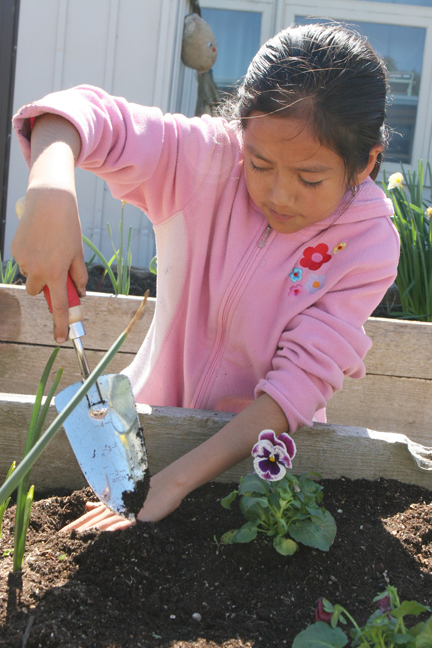Elementary school gardens a field
of learning and growing
At R. O. Hardin one of the favorite classrooms doesn’t have any
walls and the floor is covered with dirt. The learning tools are
not chalkboards and books, but living beings.
ementary school gardens a field
of learning and growing
R. O. Hardin one of the favorite classrooms doesn’t have any walls and the floor is covered with dirt. The learning tools are not chalkboards and books, but living beings. Like other elementary schools, R. O. Hardin maintains a school garden – complete with flowerbeds and a greenhouse – and it recently won an award.
The National Gardening Association singled out the elementary school from 650 other gardening programs nationwide to receive a 2007 Youth Garden Grant.
Jeanne Gilliard oversees R.O. Hardin’s garden program. Gilliard has been with R.O. Hardin for more than 20 years, though she has only been involved with the school garden for five years. She estimated that R.O. Hardin’s garden is probably around 10 years old.
Gilliard has always had a passion for gardening, she said, but it wasn’t until the school found out they were eligible for grant money that they figured out how to incorporate a student garden into the school’s curriculum.
“Part of the curriculum for the grant was that we had to start our own garden,” Gilliard said. “Now we have 39 raised beds, a greenhouse, and a [white picket] fence.” Gilliard’s third graders have to learn about the parts of plants as part of the curriculum for life sciences, so having the garden available to them helps the students understand the materials.
“When we learn about different types of seeds, the children can see them. They plant them,” Gilliard said. “The kids pull weeds in the garden and they get to see the roots. They’re amazed by that.”
Other grades benefit from R.O. Hardin’s garden as well. When the kids study soil as part of earth science curriculum during the 5th grade, they can dig in the dirt and get their hands dirty, Gilliard said. The garden works into the curriculum for social studies, because part of the third-grade curriculum requires that teachers teach students about their communities, she said. Since Hollister is such an agriculturally rich community, Gilliard said, the students understand it better because of what they grow.
Not every student is affected by the presence of the garden, but Gilliard is amazed by how many of her students grow up here and don’t understand the significance of agriculture here. Still, she has other students that have a level of experience that exceeds even hers.
“I think the kids are drawn to the garden, even some of the ones that have troubles seem to leave them in the classroom when they come out here,” Gilliard said.
R.O Hardin isn’t the only school with a garden.
Over at Ladd Lane Elementary School Erika Sanchez, a fifth-grade teacher, and Rosa Sanchez, a third-grade teacher, have been working this year to start a student garden. Rosa has incorporated the garden into her English lessons for her non-English speaking students who use the garden to learn vocabulary words when they talk about terms such as composting and recycling.
One way Erika uses the garden is to teach her students about the native plants of San Benito County. Sanchez is excited about the potential that the garden has to get kids out of the classroom and into an environment where they can be more hands-on with the materials they are learning about.
Sunnyslope School has had a student garden for almost longer than any school in the Hollister School District. Melinda Scott, the principal of Sunnyslope, said the school garden was here long before she came to the school four years ago.
In addition to the classroom work that gets done with Sunnyslope’s garden, the faculty also use it for various seasonal activities. For example, during the fall they haul in pumpkins and let the students pick out their own. Around Saint Patrick’s Day, the kindergarten teachers take their classes out and let them search for evidence of leprechauns.
“The children also plant vegetables and flowers in the spring,” Scott said. “Some of the teachers just use the space to give kids a natural place to write in their journals. Some of the kids just love being in the dirt.”
More than 50 R.O. Hardin students recently participated in a garden workday where many flats of seeds were planted in the school greenhouse. Everything from carrots to bulbs to cauliflower have been planted in the past.
One of the problems with school gardens is maintaining those gardens during breaks when students are away from school. Gilliard has put a lot of her personal time and energy into maintaining the R.O. Hardin garden and she said that other teachers and volunteers have been very gracious about helping where they could.
There are not people present to tend to the garden during the summer months, so the garden goes untended.
The National Gardening Association awarded R.O. Hardin’s garden with an assortment of books donated by the association as well as a $250 gift card from Home Depot.
One of the ways that the school may be able to use that gift card is to install a drip irrigation system that could maintain the garden during the summer months when teachers are away from school.
Patrick O’Donnell can be reached at po*******@**********ws.com.










